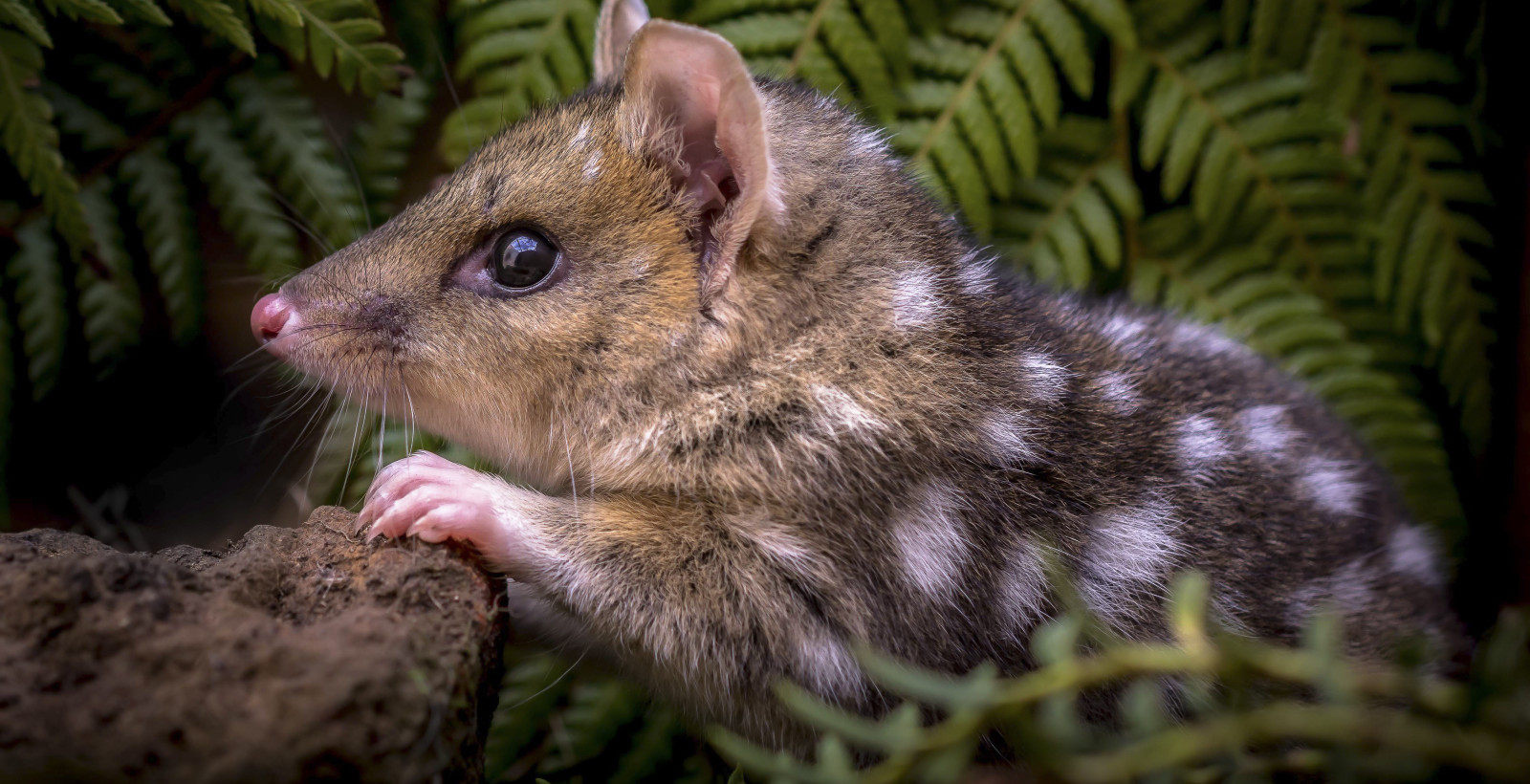Unique Wildlife of Tasmania
-
Author Inspiring Journeys
-
Date 23 May 2023
Tasmania’s nature is unparalleled in beauty and diversity, with its abundance in endemic wildlife making it a must-visit for those interested in seeing unique fauna. Spot fur seals relaxing on the rocky coastline of Bruny Island or visit Maria Island where you’ll come across pademelons, Forester kangaroos, Bennett’s wallabies and the largest living carnivorous marsupial, the Tasmanian Devil. Though known for its unique marsupials, Tasmania is also home to many interesting, vibrant and diverse bird species including the rarest wild bird in the world, the orange bellied parrot. A great way for a guaranteed encounter with some of these native animals is visiting Tasmania’s wildlife parks and sanctuaries, which have helped grow the population of endangered Tasmanian species through rescues and rehabilitation.
Tasmanian Devil
The Tasmanian Devil is a nocturnal scavenger only found in the wild of Tasmania. Although they look cute, Tasmanian Devils have been documented to have one of the strongest bites in the animal kingdom for their size. They are also the largest carnivorous marsupial in the world. When angry or threatened, they are known for making a loud screeching noise, which is believed to be where they received their name from.
Where to find Tasmanian Devils
The best place to see Tasmanian Devils is one of the excellent animal parks in Tasmania. Tasmanian Devil Conservation Park in Taranna, Tasman Peninsula near Port Arthur, or Bonorong Wildlife Sanctuary near Hobart City. If you’re visiting Cradle Mountain, you can also stop by Trowunna Wildlife Park at Mole Creek.
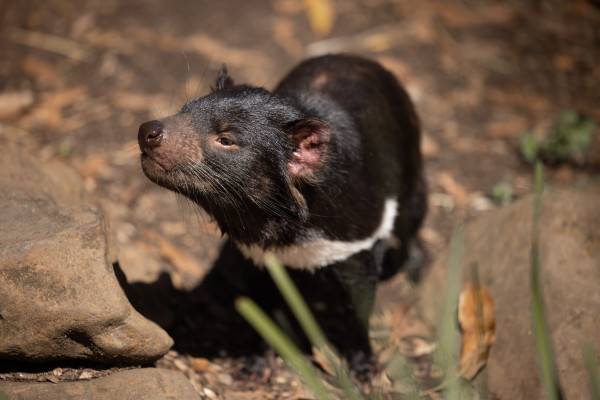 Image credit: Jess Bonde
Image credit: Jess Bonde
Tasmanian Pademelon
The Tasmanian Pademelon, also known as the Red Bellied Pademelon because of its reddish fur, was once also found in Southern Australia but are now only native to Tasmania. They are nocturnal and shy marsupials that rarely venture 100 metres away from forests where they reside. Their short stocky compact body make it easier to move through dense vegetation, which is where they spend the daylight hours. As they are nocturnal, they typically wait until after dusk to move into the open to feed on a wide variety of plants, herbs, grass and nectar bearing flowers.
Where to find Pademelons
Pademelons are abundant and widespread across mainland Tasmania and are also found on the nearby King and Furneaux Islands. They prefer rainforests and scrubland but can also be found in the wet gullies of dry open eucalyptus forests.
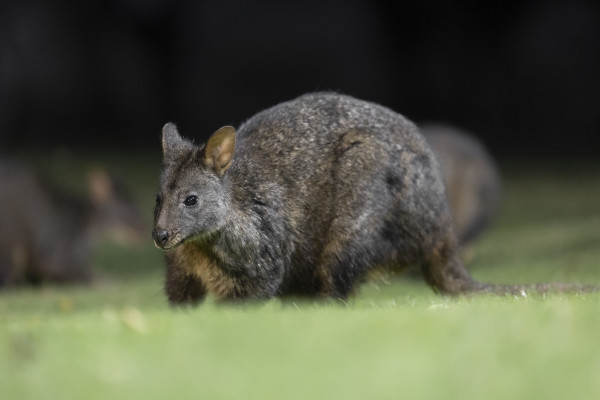 Image credit: Tourism Australia
Image credit: Tourism Australia
Eastern Quoll
This marsupial, which closely resembles a ferret, has not been sighted on the mainland since 1963, and is now only found in Tasmania. Adult Eastern Quolls are about the size of a house cat, but they have been known to be quite vicious, often getting into scraps with Tasmanian Devils over food. They are commonly found living in remote forests, grasslands and fields. The Eastern Quoll plays an important role in maintaining the balance of the ecosystem, scavenging on carrion on the forest floor.
Where to find Eastern Quolls
Within Tasmania, Eastern Quolls inhabit rainforest, alpine areas, heathland, and scrub below 1,500 metres. However, they prefer dry grassland and forest mosaics, bounded by agricultural land, particularly where pasture grubs are common. Spot them in Huon Valley and Bruny Island.
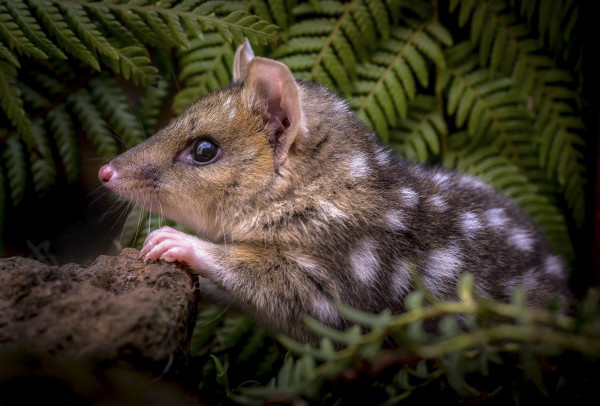 Image credit: Ash Thomson Photography
Image credit: Ash Thomson Photography
Tasmanian Wombat
The Tasmanian wombat is slightly different sub-species of the common wombat found on the Australian mainland. There is also a Flinders Island sub-species, which was also introduced to Maria Island. These marsupials may look lumbering, but they are surprisingly speedy when they want to be, able to run speeds up to 40km/hr.
Where to find Tasmanian Wombats
There are plenty of chances to see wombats in Tasmania. They are found in large numbers on Maria Island, Cradle Mountain and on Flinders Island. The best chance for a personal encounter with a wombat is to visit one of Tasmania’s wildlife sanctuaries, such as Bonorong, where rescued wombats are raised to be released back into the wild.
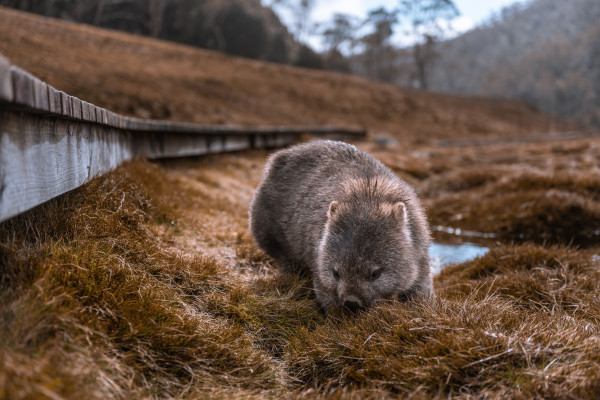 Image credit: Jess Bonde
Image credit: Jess Bonde
Tasmanian Forester Kangaroo
Found only in Tasmania, the Tasmnian Forester Kangaroo is a subspecies of the Eastern Grey Kangaroo. The largest of the Tasmanian marsupials, Tasmanian Forester Kangaroos can grow up to 6.5 feet in height and over 60kg in weight. These herbivores consume leaves, herbs, grass and other shrubs and live in grasslands or open woodlands. They live in groups called “mobs” with males asserting dominance through aggressive techniques such as “boxing”. Their numbers have dwindled since the 1800s by 90% due to being hunted for their meat and the loss of their habitat. Other factors that have reduced their numbers include climate change, poisonous baiting and disease.
Where to find Forester Kangaroos
The Tasmanian Forester Kangaroo is protected by law and can be found in the National Parks of Maria Island and Narawntapu. You can also see Forester Kangaroos at Bonorong Wildlife Sanctuary where feeding them is allowed.
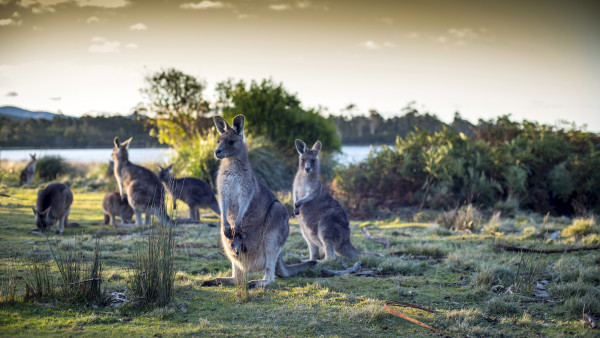 Image credit: Tourism Tasmania and Rob Burnett
Image credit: Tourism Tasmania and Rob Burnett
Bennett’s wallaby
This wallaby is distinguishable from other wallabies because of the red-tinted fur on the back of its neck and shoulders, which has earned it the alternate name “the red-necked wallaby” on mainland Australia. They have an acute sense of smell and hearing. Their large ears are capable of moving 180 degrees independently, allowing them to remain alert for potential predators. The Bennett’s wallaby typically stands at just under 1 metre tall and weigh between 14 and 18 kilograms.
Where to find Bennett’s Wallabies
Bennett’s wallabies are abundant in Tasmania and can be found throughout the state, including the Bass Strait islands. They are commonly found in eucalyptus forests and open areas with nearby tree shelter but can tolerate a diversity of habitats, including farmland. Visitors to most of Tasmania’s national parks are highly likely to encounter these animals during their stay.
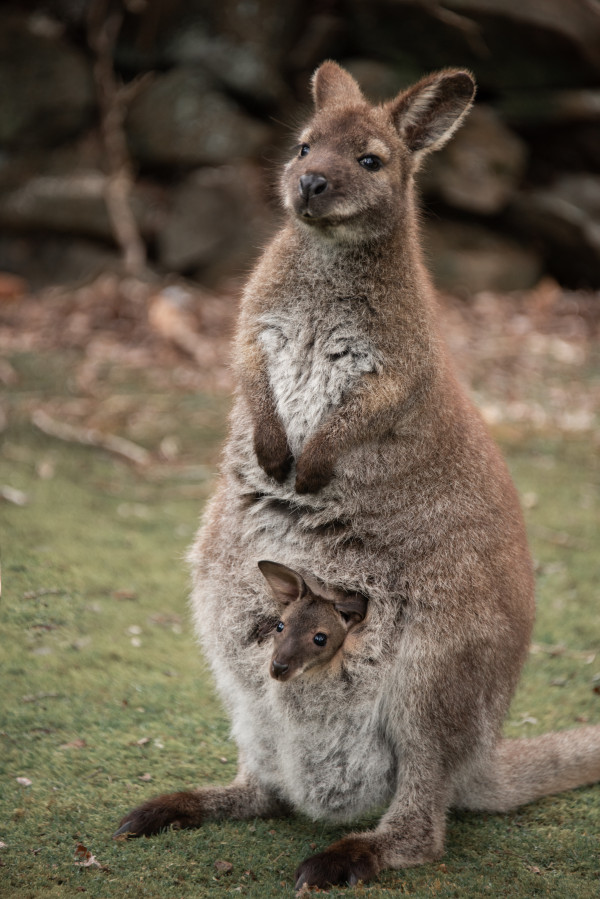 Image credit: Jess Bonde
Image credit: Jess Bonde
Tasmanian Birds
Tasmania has 12 endemic bird species which include the Tasmanian native-hen, dusky robin, green rosella, Tasmanian thornbill, yellow wattlebird, black-headed honey eater, yellow-throated honey eater, strong-billed honey eater, forty-spotted pardalote, black currawong, Tasmanian scrubwren and Tasmanian scrubtit. Tasmania is also where the Orange-bellied parrot, a migratory parrot species, breeds during the Summer. With only 50 left in the wild, it is one of the rarest wild birds in the world, with Tasmania being an integral part of its continuing population.
Tasmanian Native Hen
The Tasmanian Native Hen is a stocky flightless bird that stands at approximately 45cm with strong sturdy legs. It has a large yellow bill, red eyes, brown head, back and wings, and a grey belly. While flightless birds have a history of extinction due to human activity, the Tasmanian Native Hen actually benefitted when agriculture was introduced and are currently widespread in Tasmania. Although the Tasmanian Native Hen cannot fly, the species has been recorded running at speeds up to 48km/hr, earning it the nickname “Turbo Chook”.
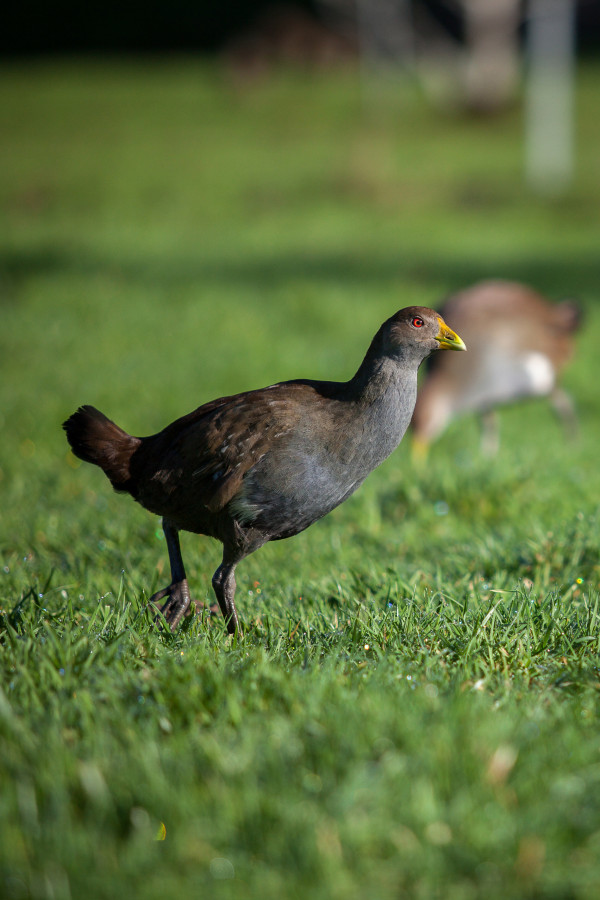 Image credit: Tourism Tasmania & Kelly Slater
Image credit: Tourism Tasmania & Kelly Slater
Endangered Tasmanian Animals
Threats, including but not limited to climate change, disease, predation from introduced species, loss of habitat and baiting has rendered some of Tasmania’s wildlife endangered.
The population of the Eastern Quoll is now in decline in Tasmania and the animal has been declared extinct in mainland Australia. This is mainly due to introduced predators such as foxes and cats. Their population decline will of course have a ripple effect due to their important role as an ecosystem engineer, scavenging on carrion on the forest floor and maintaining balance in the bush.
The Tasmanian Devil is seriously threatened by Devil Facial Tumour Disease, which develops quickly and is fatal. This highly infectious cancerous tumour usually appears around the Devil’s mouth, face and neck, and the animal will die within three to six months of its appearance. This disease, on top of human impacts such as car collisions, has led to an 80% reduction in sightings of Tasmanian Devils over the past 20 years.
At Inspiring Journeys, we’re committed to offering ethical wildlife experiences on our trips guided by TreadRight Foundation’s Animal Welfare Policy, working with partners that promote conservation and protection. Along with TreadRight, Inspiring Journeys has committed funding to support the University of Tasmania in its research to develop a vaccine against the Devil Facial Tumour Disease so that Tasmanian Devils may once again thrive in the wild.
Wildlife Parks in Tasmania
Tasmania’s wildlife parks and sanctuaries are a great place to catch a glimpse of native animals. They are also vital in rescuing and rehabilitating endangered Tasmanian species.
Bonorong Wildlife Sanctuary operates 24 hours a day, with the keepers rescuing animals in need of rehabilitation with the goal of releasing them back into the wild. The sanctuary is run by a passionate team of like-minded people who are dedicated to proactively addressing environmental and social issues in the community. A visit to Bonorong Wildlife sanctuary will allow you the unique chance to spot animals that became extinct long ago in other parts of Australia.
Freycinet National Park is iconic, memorable and breathtaking. From Wineglass Bay, with its crystal-clear waters and pearly white beach, to the Hazards – a spectacular granite mountain range that rises dramatically from the turquoise waters, Freycinet has no shortage of beautiful views. The waters off the coast are regularly visited by southern right whales during the winter months and the land hosts an abundance of mammals such as pademelons, wallabies, seals and echidnas.
Maria Island is a special place. Rich in indigenous and European history, abundant in wildlife, and boasting spectacular views and remarkable geological features, this entire island is a National Park. Once on shore, explore the convict-built Darlington township, take a walk to the Fossil Cliffs or Painted Cliffs, hire a bike, or simply relax and recharge by the waterside with your packed lunch full of local goodies. The island is also home to a number of unique animals. Since the late 1960s, a number of threatened species have been introduced as part of conservation efforts. You’ll be in good company with an abundance of wombats, kangaroos, wallabies, possums and even Tasmanian devils who all call the island home, not to mention the amazing bird watching and underwater diversity the island has to offer.
See Wildlife on Tastes of Tasmania
On our Inspiring Journeys Tastes of Tasmania tour you will visit Maria Island and Freycinet National Park, soaking up Tasmania’s wild, rugged natural beauty, while at the same time being treated to the best food and drink the island state has to offer. Experience a culinary journey where you’ll have a chance to immerse yourself in rich history and culture, indulge in local produce, explore amazing landscapes, take in breathtaking panoramic views and be in awe of the unique wildlife that you’ll spot along the way.
